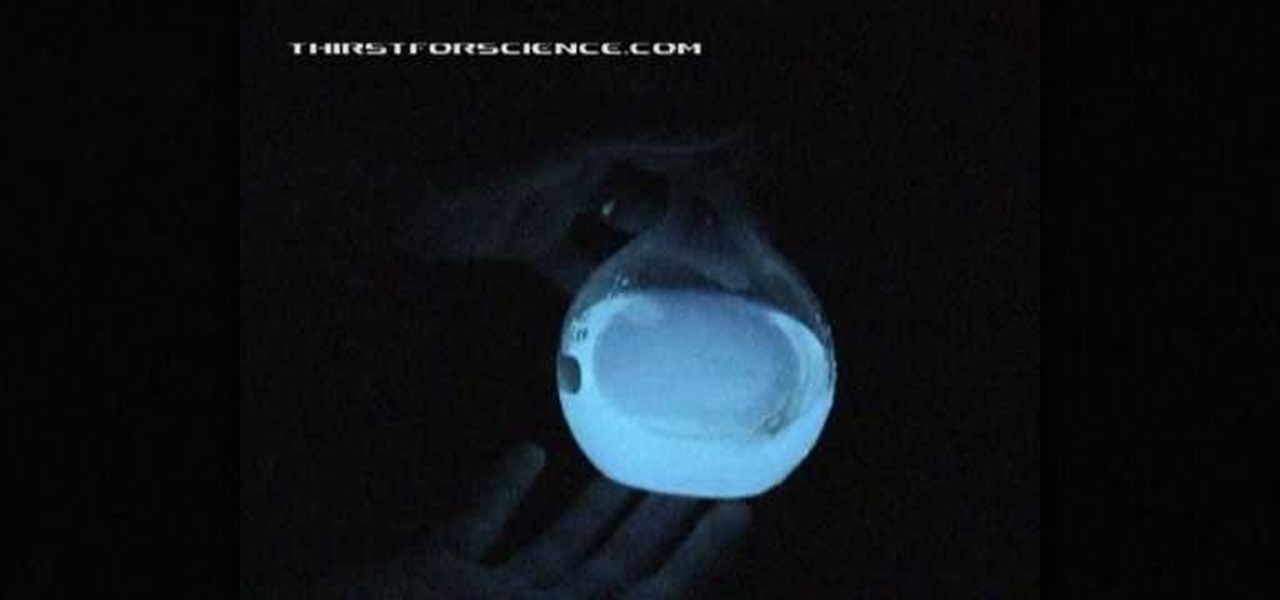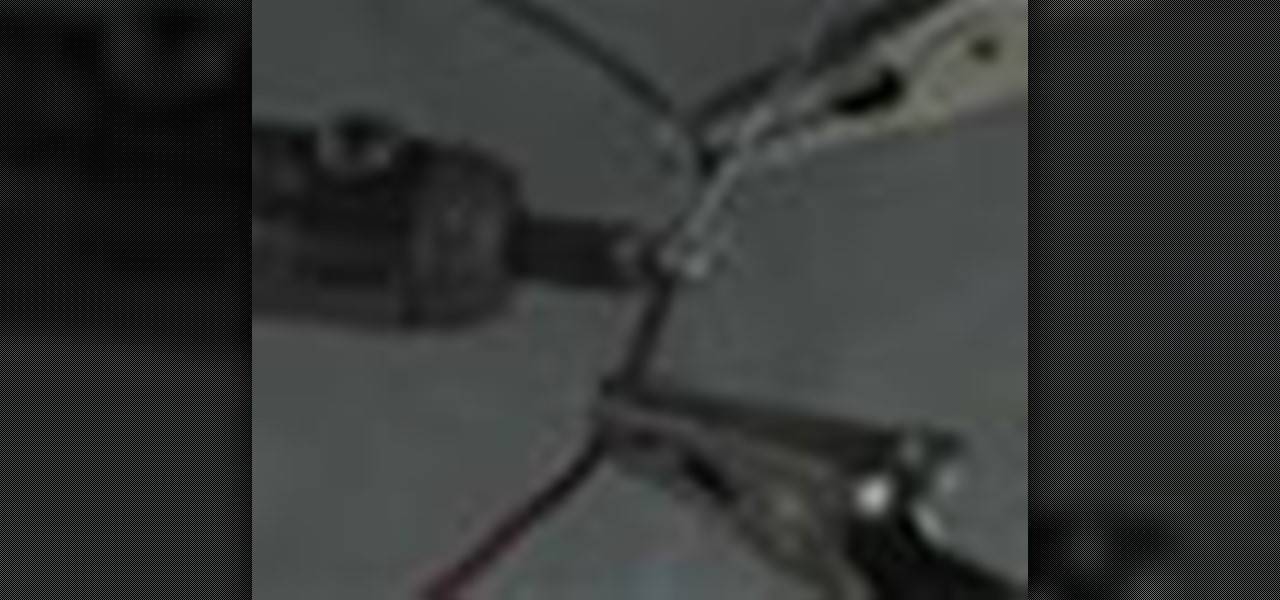
Curious about reduction & oxidation? In this two-part episode of The Science Catalyst hosted by Barry Lambson, the subject of Chemistry, reduction & oxidation is gone over with iron powder and copper sulphate. Oxidation and reduction are heavily related which is why they are both considered "redox reactions". Acids and bases may be thought of as reactions involving hydrogen, or protons, while redox reactions tend to be concerned with electron gain and loss.

In this how to video, you will learn about Chemiluminescence and the oxidation of Luminol. The first solution is Luminol and NaOH. The second is K3 and H202. Luminol is used to detect blood in crime scenes. It reacts with Iron in Hemoglobin. As you can see in the example, it illuminates the chemicals in the dark. This is why it is very useful for crime scenes. It can be used even if the blood is not visible with day light. Thus, it is an invaluable chemical in the name of science and justice....

Do you understand organic molecules or oxidization in chemistry? If you answered no then this is the video you need to watch. This video will show you grade 12 chemistry, with organic models, and will teach you about oxidization. In less than 4 minutes you will have a much better understanding of the topic. This is demonstrated with a few common chemicals which include potassium dichromate and ascorbic acid. Ascorbic acid or vitamin C is found in many foods that we eat including fruits and ve...

Everyone's car gets rusty sooner or later. This video will show you how you can remove that horrible oxidation from your car with some polish and wax. Pretty soon, your car will be rust free and looking as good as new. Remove heavy oxidation from your car.

Once you've reached an age where sparklers are no longer fun, it's time to upgrade to science and steel wool. It may be basic chemistry, but as you'll see in the video, simplicity can amaze more than complexity, as well as create some really impressive fireworks that are perfect for the Fourth of July.

C For Chemistry delves into the chemistry of science experiments. This chemist knows what he's talking about. These chemistry experiments are not only fun, but very educational for all of those interested in scientific chemical reactions and properties.

You know how sometimes you'll slice up an apple for lunch, toss it into a ziplock bag, and then open it a few hours later only to find a soggy, brown mess? Fruit discoloration due to oxidation is an everyday fact, and often the disgusting-looking browned fruit prevents us from wanting to actually eat it anymore.

Wipe headlights clean. Double tape around the headlights. Use two layers of tape around the headlight lens to protect the paint. Insert the backing plate into the drill. Attach the foam interface pad. Use a spray bottle of water to lubricate and keep headlights clean while sanding. Completely remove the old UV coating. You'll see heavy sanding marks in the headlight lens. With the 500 grit sandpaper, remove oxidation and pitting. Use uniform movements of up and down and side to side with mode...

Make sure your winter wardrobe survives the summer by putting it away properly. Learn how to store your winter clothes.

Did you just wash your car and when you ran your hand over it it STILL felt covered in a layer of dirt? That isn't dirt, it's oxidation and you can't wash it away. It's time to clay bar it. In this tutorial you will learn how to use Wolfgang products to clay bar your vehicle and get that smooth polished finish back. Clay bars remove a thin layer of paint so be careful and watch this video to make sure you clay bar your car or truck properly.

Step away from the tequila shooters and stop the morning-after agony before it starts. You Will Need

Learn how to solder. Whether you like to tinker with electronics or do your own plumbing repairs, soldering metal is an essential skill. Plus, it's kinda fun.

Ideally, wine would stay as perfect and delicious as the day it was first uncorked forever. But, thanks to a pesky process called oxidation, re-corked wine (no matter how you do it) pales in comparison to a fresh's bottles original magic.

In this video, I will show you how to make copper glow red hot with the catalytic oxidation of acetone. For this science experiment, we'll just need some acetone, copper wire, and a flame source to initially heat the copper coil we'll make.

Watch this chemistry demo of the oxidation of iron and learn how to perform this experiment yourself.

Bad news, guys. The shelf life for liquor leftovers does not apply to your two-buck chuck. While an opened bottle of your favorite whiskey will stay respectable for ages thanks to its high ABV (which makes it inhospitable to outside elements), an opened bottle of merlot will sour quickly. However, it turns out that red and white wines have different life spans once they're opened—for reasons which we'll cover below.

Letting wine "breathe" isn't just something that happens in restaurants in '80s teen comedies with snooty maître d's. It's really a thing, and you should learn how to do it at home, because it'll make just about any wine—including Two-Buck Chuck—taste much, much better. It's also astonishingly easy, and despite what the Home Shopping Network may tell you, does not require buying extra gadgets.

I own two aprons—a cute one for company, and another for the hard-core cooking duties, like cutting up chicken and making stock. The sad truth is that I almost never remember to wear either of them. So, much of my clothing ends up spattered with grease, liquid, and bits of fruit and vegetable. While stain-removing sprays, sticks, and pens are all effective to a certain extent, they have two drawbacks—they're expensive and sometimes I need to use them in large quantity, like when a piece of eg...

Pyromania is definitely nothing new on WonderHowTo. From flamethrowers and hydrogen fireballs, to flame-making pistons and wine corks, to simply burning steel wool fireworks and DIY smoke mix, we've covered it all. But when pyromaniacal mad scientists feel the need to release some tension in the lab, gummy bears and cockroaches become the victims of euphoric oxidation by way of molten potassium chlorate. A recent video by famous YouTube chemist NurdRage shows one of mankind's most despised cr...

I feel like doing a bit of chemistry today, how about you? To my knowledge, thermite is the hottest burning man-made substance. Thermite is a pyrotechnic composition of a metal powder and a metal oxide that produces an exothermic oxidation-reduction reaction known as a thermitereaction.

Everyone starts their mornings differently, but one common thread amongst the masses tends to be the consumption of coffee, albeit in many different forms—instant, pre-ground, K-Cups, Nespresso, and so on. And I'm sure that we all have our own preferred methods, as well.

Onions add essential flavor to almost any dish, whether it's a sauce, main dish, or salad. They are one of the humblest "superfoods," full of vitamins and nutrients but generally inexpensive, which is why they're also one of the most widely eaten ingredients in the world.

The best sangria I ever had in my life was made by a Spanish friend for my birthday party. The ingredients included a giant box of Franzia red, one bottle of Bombay Sapphire Blue, one cup of sugar, a liter of 7-Up, and some cinnamon sticks. She put everything but the 7-Up in a giant zinc bucket from Home Depot and insisted that it had to sit overnight so the flavors could blend (and so the Franzia wouldn't taste so, well, Franzia-ish).

In the case of rotting food, microbes are not our friends. Now, scientists have developed a new food wrap coated with tiny clay tubes packed with an antibacterial essential oil that can extend the shelf life of perishable food, so we can waste less and eat more.

Fight me all you want, but it ain't a party without alcohol—whether it's a Halloween party, Christmas party, dinner party, or even a damn wedding. (If you think that people will stick around after dinner for a dry wedding, then you're sorely mistaken.)

Theo Gray of Gray Matter explains the principle behind sending steel up in flames- as long as it's steel wool, of course. The process is beyond simple. Spend 2 bucks and 2 minutes: purchase a steel wool pad, hold in pliers, light with a match. But the question is, why is steel wool flammable, while other forms of metal are not? Explanation below the video. Theo says:

Well, Ol' Man Winter is upon us yet again, blasting us with his icy breath. When I was a kid, I loved wintertime because it meant the prospect of sledding, snowball fights & missed school days in which to enjoy both. Now that I'm 45, however, my attitude toward the season has taken a complete 180-degree turn: I find myself dreading it because of the likelihood of being snowed-in for days on end, and the certainty of being forced to endure the frigid temperatures.

Etching your own circuit boards is tons of fun, but etching requires strong chemicals to dissolve the copper plating on blank circuit boards. The normal ferric chloride solution works well, but can be expensive and leaves permanent stains. Luckily, we can whip up our own etchant at home with everyday chemicals! Better yet, our new etchant will turn an eerie green color rather than the dull brown of ferric chloride.

Homemade circuits are amazing. You can build any kind of circuit on a simple perfboard, as we have seen in previous projects. However, some projects require very tiny circuit boards. We could special order some boards from a printed circuit board (PCB) factory, but that will most likely involve a high price per board and a few thousand miles of delivery service to pay for.






























